FY2022 Annual Report
Micro/Bio/Nanofluidcs Unit
Professor Amy Shen

Abstract
Our unit members have continued to excel with their research projects and engaged with local outreach activities during FY2022. We published 20 peer-reviewed papers total, with our research highlighted in Physics Today, Science Daily, etc. The unit members have also actively disseminated our research results to the general public and scientific communities. We gave more than 54 invited and contributed presentations (including poster) and seminars in FY2022, participated virtual and in-person professional society meetings. We also organized an in-person OIST workshop (Recent Trends in Microrheology and Micorfluidics) in January 2023; an in-person OIST mini-symposium (Yielding and Flow of Soft Matter System) in February 2023. We hosted 8 zoom seminars by internationally renowned scientists, with topics covering microfluidics, rheology, and biotechnology.
Santo Chan and Ainash Garifullina obtained their Ph.D in October 2022, congratulations! We recruited 4 new Ph.D students (Fabian Hillebrand, Jonas Schneider, Jiangming Wu, Arisa Yokokoji) in FY2022. Our unit also hosted 6 Ph.D rotation students from OIST and 5 research interns (2 self funded).
Personnel wise, Tatiana Porto Santos received the prestigous Marie Curie Fellowship and will start her new adventures in Wageningen University and Research (WUR) to study food proteins in June 2023. Dan Carlson took a position as the specialist technical officier in the Faculty of Engineering and Physical Sciences, at University of Southampton (UK). We also welcomed three new postdocs: Dr. Eliane Younes from University of Nantes in France, Dr. Benjamin Heidt from Maastricht University from the Netherlands and Dr. Murali Mohan Jaligam from Birla Institute of Technology & Sciences (BITS)-Pilani.
1. Group Member
- Prof. Amy Shen, Professor
- Dr. Simon Haward, Group Leader
- Dr. Daniel Carlson, Postdoctoral Scholar
- Dr. Vincenzo Calabrese, Postdoctoral Scholar
- Dr. Stylianos Varchanis, Postdoctoral Scholar
- Dr. Tatiana Porto Dos Santos, Postdoctoral Scholar (external funding)
- Dr. Ricardo Arturo Lopez de la Cruz, Postdoctoral Scholar
- Dr. Benjamin Heidt, Postdoctoral Scholar
- Dr. Murali Mohan Jaligam, Postdoctoral Scholar (external funding)
- Dr. Eliane Younes, Postdoctoral Scholar
- Mr. Kazumi Toda-Peters, Lab Manager and Research Technician
- Ms. Arisa Yokokoji, Graduate Student
- Mr. Fabian Hillebrand, Graduate Student
- Mr. Jiangming Wu, Graduate Student
- Mr. Jonas Schneider, Graduate Student
- Ms. Hiromu Josha, Research Administrator
Alumni
- Dr. Cameron Hopkins, Postdoctoral Scholar
- Dr. Vincenzo Mazzaracchio, Postdoctoral Scholar
- Dr. Shivani Sathish, OIST POC Fellow
- Dr. San To Chan, JSPS DC2 Fellow
- Dr. Ainash Garifullina, JSPS DC2 Fellow
- Mr. Yong Heng Phua, Rotation Student
- Mr. Giulio Foggi Rota, Rotation Student
- Mr. Igors Dubanevics, Rotation Student
- Mr. Mauricio Andres Rios Maciel, Research Intern (Joined OIST PhD program in January, 2023)
- Dr. Marvin Wilhelm Detert, Research Intern (Completed his PhD in April, 2023)
- Ms. Tamara Iakimova, Research Intern
- Ms. Diana Mengdesh, Research Intern
- Ms. Irina Koriakina, Visiting Research Student
- Ms. Hien Le, Research Intern
2. Collaborations
Type of collaboration: Joint research
Researchers:
- Professor John Tsamopoulos, University of Patras, Greece
- Professor Frank Scheffold, University of Fribourg, Switzerland
- Professor Riccardo Funari, University of Bari, Italy
- Professor Steven Armes, University of Sheffield, UK
- Professor Hidehiro Fukuyama, Kansai Medical University and RIKEN, Japan
- Professor Atsushi Matsumoto, University of Fukui, Japan
- Dr. Michael Boehm and Stefan Baier, Motif, USA
- Professor Simone Pigolotti and Marco Rosti, OIST
3. Activities and Findings
3.1 Bifurcation, instability, and flow alignment of complex fluids
3.1.1 Bifurcations and instabilities in flows of complex fluids around microfluidic cylinders
(A) Upstream wall vortices in viscoelastic flow past a cylinder, Cameron C. Hopkins, Simon J. Haward, and Amy Q. Shen, Soft Matter 18: 4868-4880 (2022).
We report a novel inertia-less, elastic flow instability for a viscoelastic, shear-thinning wormlike micellar solution flowing past a microcylinder in a channel with blockage ratio BR = 2R/W = 0.5 and aspect ratio α = H/W = 5, where R = 100 μm is the cylinder radius, W is the channel width, and H is the channel height. The instability manifests upstream of the cylinder and changes form with increasing Weissenberg number over the range 0.5 < Wi = Uλ/R < 900, where U is the average flow velocity and λ is the terminal relaxation time of the fluid. Beyond a first critical Wi, the instability begins as a bending of the streamlines near the upstream pole of the cylinder that breaks the symmetry of the flow. Beyond a second critical Wi, small, time-steady, and approximately symmetric wall-attached vortices form upstream of the cylinder. Beyond a third critical Wi, the flow becomes time dependent and pulses with a characteristic frequency commensurate with the breakage timescale of the wormlike micelles. This is accompanied by a breaking of the symmetry of the wall-attached vortices, where one vortex becomes considerably larger than the other. Finally, beyond a fourth critical Wi, a vortex forms attached to the upstream pole of the cylinder whose length fluctuates in time. The flow is highly time dependent, and the cylinder-attached vortex and wall-attached vortices compete dynamically for space and time in the channel. Our results add to the rapidly growing understanding of viscoelastic flow instabilities in microfluidic geometries.

Figure 1: Time-averaged velocity fields measured for flow of the wormlike micellar solution past a BR = 0.5 cylinder at (a) Wi = 2.5, (b) Wi = 38, (c) Wi = 100, (d) Wi = 180, (e) Wi = 897.
(B) Effect of blockage ratio on flow of a viscoelastic wormlike micellar solution past a cylinder in a microchannel, Cameron C. Hopkins, Amy Q. Shen, and Simon J. Haward, Soft Matter 18: 8856-8866, (2022).
We present experiments on the flow of a viscoelastic wormlike micellar solution around cylinders (radius R) confined in straight microchannels (width W). Thirteen flow geometries are tested where the blockage ratio is varied over a wide range 0.055 < BR = 2R/W < 0.63. Experiments are performed at negligible Reynolds number, and for Weissenberg numbers Wi = λU/R up to 1000, where U is the average flow speed and λ is the relaxation time of the fluid. Micro-particle image velocimetry is used to characterise the flow state at each BR and Wi. In all of the geometries, a first critical Weissenberg number marks a transition from symmetric flow to an asymmetric but time-steady flow state, while a second higher critical Weissenberg number marks the onset of time-dependent flows. However, we report a clear shift in behaviour over a narrow intermediate range of 0.33 < BR < 0.41. Channels with BR < 0.33 fall in a ‘low’ BR regime, with instabilities that originate from the downstream stagnation point, while those with BR > 0.44 fall in a ‘high’ BR regime, with instabilities developing at the upstream stagnation point. Behaviour within the newly-identified intermediate BR regime is complex due to the competing influence of the two stagnation points. We summarise all our results in a flow state diagram covering Wi-BR parameter space, clearly defining the different regimes of blockage ratio for the first time. Our results contribute to the understanding of the complexities of viscoelastic flow in this bench-mark geometry.

Figure 2: (a) Flow state diagram in Wi–BR state space. Coloured symbols represent different steady and time-dependent flow states depicted to the right, as indicated by corresponding symbols: (b) low-Wi ‘symmetric’ state (BR = 0.2, Wi = 9.5); (c) ‘laterally asymmetric’ state (BR = 0.2, Wi = 43); (d) ‘upstream bending streamlines’ (BR = 0.48, Wi = 53); (e) ‘upstream wall vortices’ (BR = 0.48, Wi = 82); (f) ‘time-dependent laterally asymmetric’ state (BR = 0.1, Wi = 257); (g) ‘asymmetric jetting’ (BR = 0.2, Wi = 384); (h) ‘time-dependent upstream wall vortices’ (BR = 0.44, Wi = 160); (i) ‘upstream cylinder vortex’ (BR = 0.48, Wi = 481).
3.1.2 Elastic turbulence in porous media and canopy flows
(A) Canopy elastic turbulence: Spontaneous formation of waves in beds of slender microposts, Charlotte de Blois, Simon J. Haward, and Amy Q. Shen, Physical Review Fluids 8: 023301 (2023).
In a viscoelastic flow over a microfluidic canopy of polymeric pillars, we report the spontaneous emergence of waves in the form of propagating regions of low flow velocity compared to the surrounding flow. The occurrence of the wave is chaotic and shows characteristics of elastic turbulence. We systematically study the coupling between the low-velocity wave and the microfluidic canopy by combining flow velocimetry experiments and high-speed tracking of the pillars. The waves form an angle ±β with the primary flow direction that depends on the geometry of the pillar array. If the canopy is composed of flexible structures, the passage of a wave deflects the structures locally in a manner reminiscent of the emergence of the Monami waves observed in inertial turbulence over canopies of vegetation. Due to the analogies with classical (inertial) canopy turbulence, we name our observed phenomenon canopy elastic turbulence.

Figure 3: Microfluidic canopy flow device, formed from a large array of slender polymeric pillars within a glass microchannel, is subjected to viscoelastic flow in the regime of elastic turbulence. The system results in the spontaneous emergence of waves in the form of propagating regions of low flow velocity compared to the bulk, also inducing Monami-like waves in the canopy if the pillars are flexible. Due to the analogies with classical (inertial) canopy turbulence, this new phenomenon is named “canopy elastic turbulence”.
(B) Volumetric evolution of elastic turbulence in porous media, Daniel W. Carlson, Kazumi Toda-Peters, Amy Q. Shen, Simon J. Haward. Journal of Fluid Mechanics 950, A36, (2022).
Viscoelastic flow instability, which is compelled by elastic effects rather than inertia, can be driven to a chaotic state termed elastic turbulence (ET) manifested as strong velocity fluctuations with an algebraic decay in the frequency spectrum and increased mixing. We report the first spatiotemporally complete description of ET by considering a broad volume within a novel three-dimensional ordered porous medium, reconstructing flow at a micrometre characteristic length scale (Reynolds numbers≪1) via time-resolved microtomographic particle image velocimetry. Beyond a critical Weissenberg number of 2, we observe an elastic flow instability accompanied by an enhanced pressure drop with spectral characteristics typical of ET. Polymer chains in the ET flow state are advected along increasingly curved streamlines between pores such that they accumulate strain and generate a local flow instability evaluated per an established instability criterion based on local evaluation of elastic tensile stress and streamline curvature. The onset of ET leads to increased pore-scale resistance and positive feedback on upstream streamline curvature. ET is thus characterized by a continuous evolution between states of laminar and unstable flow: pores with unstable flow flood their adjacent peers and thus encourage straightened streamlines and flow stability across the array, while positive feedback from flow resistance on streamline curvature results in the instability propagating upstream along the array. By employing a geometrically ordered medium, we permit flow state communication between pores, yielding generalized insights highlighting the significance of spatial correlation and flow history, and thus provide new avenues for explaining the mechanisms of ET.

Figure 4: A cross-section of high Weissenburg number flow through the porous medium, with streamlines colored by an elastic instability criterion
(C) Perspectives on viscoelastic flow instabilities and elastic turbulence, Sujit S. Datta, Arezoo M. Ardekani, Paulo E. Arratia, Antony N. Beris, Irmgard Bischofberger, Gareth H. McKinley, Jens G. Eggers, J. Esteban López-Aguilar, Suzanne M. Fielding, Anna Frishman, Michael D. Graham, Jeffrey S. Guasto, Simon J. Haward, Amy Q. Shen, Sarah Hormozi, Alexander Morozov, Robert J. Poole, V. Shankar, Eric S. G. Shaqfeh, Holger Stark, Victor Steinberg, Ganesh Subramanian, and Howard A. Stone, Physical Review Fluids 7: 080701, (2022).
Viscoelastic fluids are a common subclass of rheologically complex materials that are encountered in diverse fields from biology to polymer processing. Often the flows of viscoelastic fluids are unstable in situations where ordinary Newtonian fluids are stable, owing to the nonlinear coupling of the elastic and viscous stresses. Perhaps more surprisingly, the instabilities produce flows with many of the hallmarks of turbulence—even though the effective Reynolds numbers may be O(1) or smaller. We provide perspectives on viscoelastic flow instabilities by integrating the input from speakers at a recent international workshop: historical remarks, characterization of fluids and flows, discussion of experimental and simulation tools, and modern questions and puzzles that motivate further studies of this fascinating subject. The materials here will be useful for researchers and educators alike, especially as the subject continues to evolve in both fundamental understanding and applications in engineering and the sciences.

Figure 5: Transitions to steady asymmetric flow states in various geometries constructed from microscale cylinders as the Weissenberg number is increased beyond a critical value Wic. (a) Flow past a single cylinder positioned on the flow axis. (b) Velocity fields for flow past side-by-side cylinders with different dimensionless intercylinder gap, G = L1/(L1 + L2), where L1 and L2 are the cylinder-cylinder and cylinder-wall gaps, respectively. (c) Velocity fields for flow past two axially aligned cylinders. (d) Retardation fields for flow through a hexagonal array of cylinders. All cases show the flow from left to right of a shear-thinning viscoelastic WLM solution.
3.1.3 Structure-property relationship of a soft colloidal glass in simple and mixed flows
(A) Alignment of Colloidal Rods in Crowded Environments, Vincenzo Calabrese, Stylianos Varchanis, Simon J. Haward, Amy Q. Shen, Macromolecules, 55, 5610-5620, (2022).
Understanding the hydrodynamic alignment of colloidal rods in polymer solutions is pivotal for manufacturing structurally ordered materials. How polymer crowding influences the flow-induced alignment of suspended colloidal rods remains unclear when rods and polymers share similar length scales. We tackle this problem by analyzing the alignment of colloidal rods suspended in crowded polymer solutions and comparing that to the case where crowding is provided by additional colloidal rods in a pure solvent. We find that the polymer dynamics govern the onset of shear-induced alignment of colloidal rods suspended in polymer solutions, and the control parameter for the alignment of rods is the Weissenberg number, quantifying the elastic response of the polymer to an imposed flow. Moreover, we show that the increasing colloidal alignment with the shear rate follows a universal trend that is independent of the surrounding crowding environment. Our results indicate that colloidal rod alignment in polymer solutions can be predicted on the basis of the critical shear rate at which polymer coils are deformed by the flow, aiding the synthesis and design of anisotropic materials.
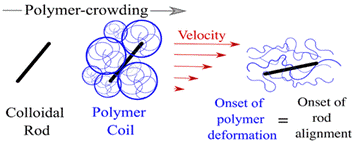
Figure 6: Cartoon of colloidal rods in a crowding environment composed of a polymer solution under shear flow.
(B) Microstructural Dynamics and Rheology of Worm-like Diblock Copolymer Nanoparticle Dispersions under a Simple Shear and a Planar Extensional Flow, Vincenzo Calabrese, Csilla György, Simon J. Haward, Thomas J. Neal, Steven P. Armes, Amy Q. Shen, Macromolecules, 55, 10031-10042, (2022).
We investigate the shear and extensional flow behavior of dispersions composed of two types of worm-like nanoparticles (WLNPs) with comparable cross-sectional diameters, similar persistence lengths but differing contour lengths, and thus differing flexibility. By measuring the flow-induced birefringence (FIB) of WLNP dispersions in two contrasting microfluidic devices, we obtain an experimental quantification of the role of shearing and planar extensional flows at aligning a short and stiff WLNP (S-WLNP) and a relatively long and flexible WLNP (L-WLNP). We show that shear and extensional flows induce the alignment of both types of WLNPs. However, extensional deformations are more effective than shear deformations at triggering the onset of alignment of the WLNP. The difference between shear and extensional deformations for WLNP alignment is explained based on the ratio of extensional and shear viscosity of the solvent fluid (Trouton ratio of the solvent) and a structural parameter related to the WLNP extensibility and flexibility. Under shear flow, these WLNP dispersions display shear-thinning behavior, with an exponential reduction in viscosity with increasing alignment. Under extensional flow, the WLNP alignment leads to extensional thinning, making WLNP ideal additives for industrial and biotechnology formulations exposed to extensional dominated flows (e.g., jetting, spraying, and printing processes).
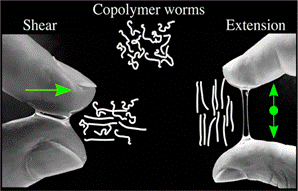
Figure 7: Cartoon of copolymer worms under a shear- and extension-dominated flows.
(C) Flow-induced alignment of protein nanofibril dispersions, Tatiana P. Santos, Vincenzo Calabrese, Michael W. Boehm, Stefan K. Baier, and Amy Q. Shen, Journal of Colloid and Interface Science, 638, 487-497, (2023).
Protein nanofibrils (PNF) resulting from the self-assembly of proteins or peptides can present structural ordering triggered by numerous factors, including the shear flow. We use β-lactoglobulin PNF aqueous dispersions with different average contour lengths but equal persistence lengths. We employ simple shear-dominated microfluidic devices with state-of-the-art imaging techniques: flow-induced birefringence (FIB) and micro-particle image velocimetry (µ-PIV), to probe the effect of shear flow on PNF alignment. We provide an empirical relationship connecting the birefringence (quantifying the extent of PNF alignment), and the Péclet number Pe (correlating the shear rate of the flow relative to the rotational diffusion of PNF) to understand the flow-alignment behavior of PNF under shear-dominated flows. Furthermore, we assess the alignment and flow profile of PNF at both high and low flow rates. The length of PNF emerges as a controlling parameter capable of modulating PNF alignment at specific shear rates. Our results shed new insights into the hydrodynamic behavior of PNF, which is highly relevant to various industrial processes involving the fibril systems.

Figure 8: Flow-induced alignment of protein nanofibrils.
3.1.4 Torsional instability of viscoelastic liquid bridges
(A) Torsional instability of constant viscosity elastic liquid bridges, San To Chan, Stylianos Varchanis, Simon J. Haward, Amy Q. Shen, PNAS nexus, 2 (3), pgad042, (2023).
Many commonplace fluids (paints, adhesives, pastes, and foodstuffs like chocolate) have more complex thixotropic elastoviscoplastic (TEVP) properties that depend on the imposed stress and the timescale of deformation. Using a commercial thermal paste, we show that liquid bridges of TEVP fluids can also be broken by torsion, demonstrating the applicability of the technique for improved dispensing of real industrial fluids. The liquid bridge breaking mechanism is an elastic instability known as “edge fracture.” Dimensional analysis predicts that the effects of thixotropy and plasticity can be neglected during edge fracture. Simulation using a nonlinear, phenomenological TEVP constitutive model confirms such a prediction. This work yields new insight into the free-surface flows of TEVP fluids, which may be important to processes such as electronic packaging, additive manufacturing, and food engineering.

Figure 9: Snapshots of the TEVP liquid bridge subjected to different rotational speeds Ω captured at different times t.
(B) Prevention of edge fracture using a nontoxic liquid metal sealant, San To Chan, Simon J. Haward, Amy Q. Shen, Physics of Fluids, 35 (1), 011704, (2022).
Edge fracture, the sudden indentation of a viscoelastic fluid's free surface, often occurs when a sufficiently strong shear is applied to the fluid, rendering rheological measurements at high shear rates difficult. We show that sealing the fluid sample's free surface with the nontoxic liquid metal Galinstan can delay fracture occurrence, extending the measurable shear rate range of a cone-and-plate fixture by a decade. The method's effectiveness is compared to the cone-partitioned plate fixture, an existing tool for mitigating the adverse effects of sample fracture. This cheap yet effective way to prevent edge fracture will benefit the general rheological study of complex fluids.

Figure 10: Schematics of the rheometer fixtures used in the current study. (a) Cone-and-plate fixture with the fluid sample (red) sealed with liquid metal galinstan (light gray) contained using a rubber gasket (light brown). Rp = 12.5 mm, Φ= 1°. (b) Cone-partitioned plate fixture. Ri = 5 mm, Rp = 12.5 mm, Φ= 5.73°.
3.2 Rheology and interfacial science of complex fluids
3.2.1 Rheological scaling of ionic-liquid-based polyelectrolytes in ionic liquid solutions: the effect of the ion diameter of ionic liquids, Atsushi Matsumoto and Amy Q. Shen, Rheological Scaling of Ionic Liquid-Based Polyelectrolytes in the Semidilute Unentangled Regime from Low to High Salt Concentrations, Soft Matter, 18, 4197, (2022).
We investigate the effect of the ion diameter a of ionic liquids (ILs) on the shear viscosity of polymerized ionic liquids (PILs) in IL solutions. When both the PIL and IL contain large PFSI anions (a ≈ 0.57 nm), the specific viscosity ηsp first decreases with increasing IL concentration cIL in the low cIL regime, reaches a minimum and then increases with increasing cIL in the high cIL regime. By comparing the measured ηsp with the modified charge screening model proposed in our previous study [Matsumoto et al., Macromolecules, 2021, 54, 5648–5661], we attribute the observed non-monotonic trend of ηsp against cIL to the charge underscreening phenomenon, i.e., an increase of the screening length at high cIL leads to the upturn of ηsp. On the other hand, when the PIL and IL contain small BF4 anions (a ≈ 0.34 nm), the ηsp decreases asymptotically with increasing cIL, because the charge on the PIL chain is likely screened fully in the entire cIL regime. Our results demonstrate that the ion diameter of ILs plays an important role in governing the charge screening mechanism of PILs in IL solutions, and thus influencing the viscoelastic properties of PIL solutions.

Figure 11: The electrostatic interaction plays an important role in determining the viscoelastic properties of PIL solutions. Our results demonstrate that the ion diameter of IL ions is a key parameter determining the charge screening mechanism and thus the viscoelastic properties of PILs in IL solutions.
3.2.2 Evaluation of constitutive models for shear-banding wormlike micellar solutions in simple and complex flows, Stylianos Varchanis, Simon J. Haward, Cameron C. Hopkins, John Tsamopoulos, Amy Q. Shen, Journal of Non-Newtonian Fluid Mechanics, 307, 104855, (2022).
Wormlike micellar solutions possess complex rheology: when exposed to a flow field, the wormlike micelles may orientate, stretch, and break into smaller micelles. Entangled wormlike micellar solutions exhibit shear banding characteristics: macroscopic bands with different local viscosities are organized and stacked along the velocity gradient direction, leading to a non-monotonic flow curve in simple shear. We present a systematic analysis of four commonly used constitutive models that can predict a non-monotonic flow curve and potentially describe the rheology of entangled wormlike micellar solutions with shear-banding characteristics: the Johnson–Segalman, the Giesekus, the thixotropic viscoelastic, and the Vasquez–Cook–McKinley (VCM) models. All four constitutive models contain a stress diffusion term, to account for a smooth transition between the shear bands and ensure a uniqueness of the numerical solution. Initially, the models are fitted to shear and extensional experimental data of a shear-banding wormlike micellar solution. Subsequently, they are employed to solve three non-homogeneous flows: the Poiseuille flow in a planar channel, the flow in a cross-slot geometry, and the flow past a cylinder in a straight channel. Each of these flows exposes the wormlike micellar solution to different flow kinematics (shear, extensional, and mixed), revealing different aspects of its rheological response. The predictive capability of each model is evaluated by directly comparing the numerical results to previously published experimental data obtained from microfluidic devices with corresponding flow configurations. While all the models can describe qualitatively the characteristic features observed experimentally in the benchmark flows, such as plug-like velocity profiles and elastic instabilities, none of them yields a quantitative agreement. Based on the overall performance of the models and also accounting for their differing numerical complexity, we conclude that the Giesekus model is at present the most suitable constitutive equation for simulating shear banding wormlike micellar solutions in flows that exhibit both shear and extensional deformations. However, the quantitative mismatch between model predictions and experiments with wormlike micellar solutions demand that improved constitutive models be developed in future works.

Figure 12: Contours of the (b) experimentally measured dimensionless principal stress difference versus the predictions of the (c) Johnson-Segalman, (d) Giesekus, and (e) thixotropic viscoelastic models.
3.2.3 Evaporation driven smart patterning of microparticles on a rigid-soft composite substrate, Rameez Iqbal, Atsushi Matsumoto, Daniel W. Carlson, Kazumi Toda-Peters, Riccardo Funari, Ashis H. Sen, Amy Q. Shen. Journal of Colloid and Interface Science, 623, 927-937, (2022).
A composite PDMS substrate containing soft cores of various shapes (circular and non-circular) surrounded by rigid matrices was fabricated by employing 3D printing and soft lithography. A sessile suspension droplet containing spherical microparticles was deposited on the composite substrate and evaporated under ambient conditions. The evaporation dynamics was recorded and analyzed. Evaporation-induced patterning (in circular, triangular, and rectangular areas) with sizes ranging from microns to millimetres were obtained. For the first time, by varying the ratio of the rigid-soft regions in the PDMS substrate, we were able to obtain different deposition sizes and shapes from an identical droplet. Instead of using lithographically patterned substrate, our simple methodology by using 3D printing and soft lithography opened up a new avenue for patterning microparticles based on a rigid-soft composite substrate.
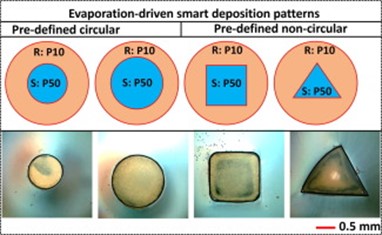
Figure 13: (Top) desired deposition patterns. (Bottom) particle depositions achieved via compound rigid-soft composite substrates.
3.3 Biophysics and biotechnology at the nano-bio-interface
Our unit has been developing various sensor platforms whereas nanofabrication, surface chemistry, and device integration are equally important to achieve superior biosensing performance.
3.3.1 Duplex electrochemical microfluidic sensor for COVID-19 antibody detection: natural versus vaccine-induced humoral response, Vincenzo Mazzaracchio, Mauricio R. Maciel, Tatiana P. Santos, Kazumi Toda-Peters, Amy Q. Shen, Small, 2207731, (2023).
The rapid transmission and resilience of coronavirus disease 2019 (COVID-19) have led to urgent demands in monitoring humoral response for effective vaccine development, thus a multiplex co-detection platform to discriminate infection-induced from vaccine-induced antibodies is needed. Here a duplex electrochemical immunosensor for co-detection of anti-nucleocapsid IgG (N-IgG) and anti-spike IgG (S-IgG) is developed by using a two-working electrode system, via an indirect immunoassay, with antibody quantification obtained by differential pulse voltammetry. The screen-printed electrodes (SPEs) are modified by carbon black and electrodeposited gold nanoflowers for maximized surface areas, enabling the construction of an immunological chain for S-IgG and N-IgG electrochemical detection with enhanced performance. Using an optimized immunoassay protocol, a wide linear range between 30–750 and 20–1000 ng mL−1, and a limit of detection of 28 and 15 ng mL−1 are achieved to detect N-IgG and S-IgG simultaneously in serum samples. This duplex immunosensor is then integrated in a microfluidic device to obtain significantly reduced detection time (≤ 7 min) while maintaining its analytical performance. The duplex microfluidic immunosensor can be easily expanded into multiplex format to achieve high throughput screening for the sero-surveillance of COVID-19 and other infectious diseases.
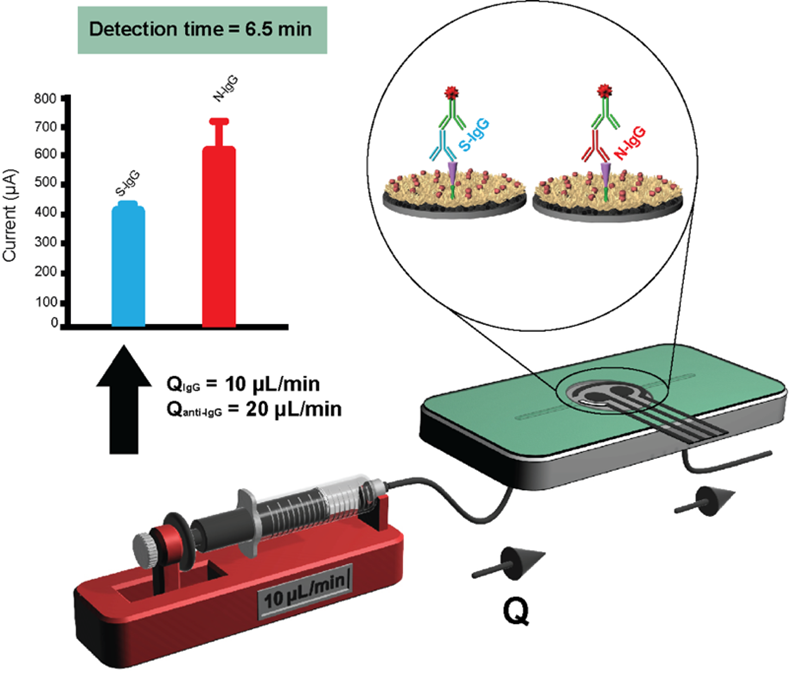
Figure 14: Duplex electrochemical microfluidic sensor for COVID-19 antibody detection: natural versus vaccine-induced humoral response
3.3.2 Multiplex biosensing for COVID-19 vaccines, Riccardo Funari, Hidehiro Fukuyama, Amy Q. Shen, Nanoplasmonic multiplex biosensing for COVID-19 vaccines, Biosensors and Bioelectronics, 208, 114193, (2022).
The ongoing emergence of severe acute respiratory syndrome caused by the new coronavirus (SARS-CoV-2) variants requires swift actions in identifying specific antigens and optimizing vaccine development to maximize the humoral response of the patient. Measuring the specificity and the amount of antibody produced by the host immune system with high throughput and accuracy is critical to develop timely diagnostics and therapeutic strategies. Motivated by finding an easy-to-use and cost-effective alternative to existing serological methodologies for multiplex analysis, we develop a proof-of-concept multiplex nanoplasmonic biosensor to capture the humoral response in serums against multiple antigens. Nanoplasmonic sensing relies on the wavelength shift of the localized surface plasmon resonance (LSPR) peak of gold nanostructures upon binding interactions between the antibodies and the immobilized antigens. Here the antigens are first immobilized on different sensing areas by using a mono-biotinylation system based on the high affinity interaction between biotin and streptavidin. We then validate the multiplex platform by detecting the presence of 3 monoclonal antibodies against 3 antigens (2 different hemagglutinins (HAs) from influenza viruses, and the SARS-CoV-2 Spike RBD (receptor binding domain)). We also measure the humoral response in murine sera collected before and after its immunization with the SARS-CoV-2 Spike protein, in good agreement with the results obtained by the ELISA assay. Our nanoplasmonic assays have successfully demonstrated multiple serum antibody profiling, which can be further integrated with microfluidics as an effective high throughput screening platform in future studies for the ongoing SARS-CoV-2 vaccine development.
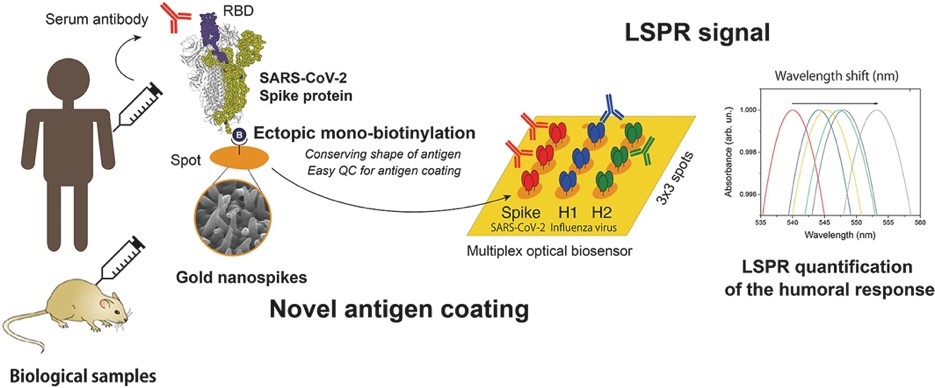
Figure 15: Nanoplasmonic multiplex sensor is developed using surface patterning and biotin tag-based protein functionalization methods. Our methodology can be used to establish high throughput screening platform for the SARS-CoV-2 vaccine development.
4. Publications
4.1 Journals
Microfluidics, Rheology, and Interfacial Science
- Vincenzo Mazzaracchio, Mauricio Rios Maciel, Tatiana Porto Santos, Kazumi Toda-Peters, Amy Q. Shen, Duplex electrochemical microfluidic sensor for COVID-19 antibody detection: natural versus vaccine-induced humoral response, Small, (2023). OPEN ACCESS
- San To Chan, Stylianos Varchanis, Amy Q Shen, Simon J Haward, Edge fracture of thixotropic elastoviscoplastic liquid Bridges, PNAS Nexus, pgad042, (2023). OPEN ACCESS
- Charlotte de Blois, Simon J. Haward, and Amy Q. Shen, Canopy elastic turbulence: Spontaneous formation of waves in beds of slender microposts, Physical Review Fluids, 8, 023301, (2023). OPEN ACCESS
- Tatiana P. Santos, Vincenzo Calabrese, Michael W. Boehm, Stefan K. Baier, Amy Q. Shen, Flow-induced alignment of protein nanofibril dispersions, Journal of Colloid and Interface Science, 638, 487-497, (2023). OPEN ACCESS
- San To Chan, Simon J Haward, Amy Q Shen, Prevention of edge fracture using a non-toxic liquid metal sealant, Physics of Fluids, (2023). OPEN ACCESS
- A. Syrakos, O. Oxtoby, E. de Villiers, S. Varchanis, Y. Dimakopoulos, J. Tsamopoulos, “A unification of least-squares and Green-Gauss gradients under a common projection-based gradient reconstruction framework”, accepted in Mathematics and Computers in Simulation, 205, 108-141, (2023). OPEN ACCESS
- P. Moschopoulos, S. Varchanis, A. Syrakos, Y. Dimakopoulos, J. Tsamopoulos, “S-PAL: A stabilized finite element formulation for computing viscoplastic flows”, Journal of non-Newtonian Fluid Mechanics, 309, 104883, (2022). OPEN ACCESS
- S. Varchanis and J. Tsamopoulos, “Numerical simulations of interfacial and elastic instabilities”, Science Talks, 3, 100053 (2022). OPEN ACCESS
- Cristhian R. L. Francisco, Tatiana P. Santos, Rosiane L. Cunha, Design of shear-based microfluidic channels for production and stability assessment of food emulsions, Current Opinion in Food Science, 49, 100957, (2022). OPEN ACCESS
- Daniel W Carlson, Kazumi Toda-Peters, Amy Q Shen, Simon J Haward, Volumetric evolution of elastic turbulence in porous media, Journal of Fluid Mechanics, 950, A36, (2022). OPEN ACCESS
- Vincenzo Calabrese, Csilla György, Simon J. Haward, Thomas J. Neal, Steven P. Armes, and Amy Q. Shen, Microstructural Dynamics and Rheology of Worm-like Diblock Copolymer Nanoparticle Dispersions under a Simple Shear and a Planar Extensional Flow, Macromolecules, (2022). OPEN ACCESS
- Cristhian R. L. Francisco, Tatiana P. Santos, Rosiane L. Cunha, Nano and micro lupin protein-grape seed extract conjugates stabilizing oil-in-water emulsions, Food Hydrocolloids, 135, 108117, (2022). OPEN ACCESS
- Lopez de la Cruz, Ricardo Arturo and Diddens, Christian and Zhang, Xuehua and Lohse, Detlef, Oscillatory droplet dissolution from competing Marangoni and gravitational flows, Physical Review Fluids, 7, 094006, (2022). OPEN ACCESS
- Sujit S Datta, Arezoo M Ardekani, Paulo E Arratia, Antony N Beris, Irmgard Bischofberger, Gareth H McKinley, Jens G Eggers, J Esteban López-Aguilar, Suzanne M Fielding, Anna Frishman, Michael D Graham, Jeffrey S Guasto, Simon J Haward, Amy Q Shen, Sarah Hormozi, Alexander Morozov, Robert J Poole, V Shankar, Eric SG Shaqfeh, Holger Stark, Victor Steinberg, Ganesh Subramanian, Howard A Stone, Perspectives on viscoelastic flow instabilities and elastic turbulence, Physical Review Fluids, 7, 080701, (2022). OPEN ACCESS
- Vincenzo Calabrese, Stylianos Varchanis, Simon J. Haward, Amy Q. Shen, Alignment of colloidal rods in crowded environments, Macromolecules, (2022). OPEN ACCESS
- Stylianos Varchanis, Simon J. Haward, Cameron C. Hopkins, John Tsamopoulos, Amy Q. Shen, Evaluation of constitutive models for shear-banding wormlike micellar solutions in simple and complex flows, Journal of Non-Newtonian Fluid Mechanics, (2022), OPEN ACCESS
- Cameron Hopkins, Simon J. Haward, Amy Q. Shen, Upstream wall vortices in viscoelastic flow past a cylinder, Soft Matter, (2022). OPEN ACCESS. Cover Image
- Rameez Iqbal, Atsushi Matsumoto, Daniel Carlson, Kazumi Toda Peters, Riccardo Funari, Ashis K. Sen, Amy Q. Shen, Evaporation driven smart patterning of microparticles on a rigid-soft composite substrate, Journal of Colloid and Interface Science, 623, 927-937, (2022). OPEN ACCESS
Biosensors and BioMEMs
- Riccardo Funari, Hidehiro Fukuyama, Amy Q. Shen, Nanoplasmonic multiplex biosensing for COVID-19 vaccines, Biosensors and Bioelectronics, (2022). OPEN ACCESS
- Hsieh-Fu Tsai, Daniel W. Carlson, Anzhelika Koldaeva, Simone Pigolotti, Amy Q. Shen, Optimization and fabrication of multi-level microchannels for long-term imaging of bacterial growth and expansion, Micromachines, (2022). OPEN ACCESS
4.2 Oral and Poster Presentations
- Simon J. Haward, Francisco Pimenta, Stylianos Varchanis, Kazumi Toda-Peters, Gareth H. McKinley, Manuel A. Alves, Amy Q. Shen, Optimized Microfluidic Device for Uniaxial and Biaxial Elongation of Mobile Fluids, Workshop on: Recent Trends in Microrheology and Microfluidics, January 2023.
- Simon J. Haward, Cameron C. Hopkins, Amy Q. Shen, Geometric Effects on the Dynamics of Viscoelastic Porous Media Flows, Minisymposium on: Yielding and Flow of Soft Matter Systems, February 2023
- Emily Y. Chen, Christopher J. Browne, Simon J. Haward, Amy Q. Shen, Sujit S. Datta, Influence of geometric ordering on viscoelastic flow instabilities in 3D porous media, 93rd Society of Rheology (SOR) Annual Meeting, October 2022
- Emily Y. Chen, Christopher J. Browne, Simon J. Haward, Amy Q. Shen, Sujit S. Datta, Influence of geometric ordering on viscoelastic flow instabilities in 3D porous media, American Physical Society Division of Fluid Dynamics 75th Annual Meeting, November 2022
- Emily Y. Chen, Christopher J. Browne, Simon J. Haward, Amy Q. Shen, Sujit S. Datta, Influence of geometric ordering on viscoelastic flow instabilities in 3D porous media, American Physical Society March Meeting, March 2023
- Daniel W. Carlson, Simon J. Haward, Amy Q. Shen, Volumetric evolution of elastic turbulence in porous media, 93rd Society of Rheology (SOR) Annual Meeting, October 2022
- Simon J. Haward, Francisco Pimenta, Stylianos Varchanis, Kazumi Toda-Peters, Manuel A. Alves, Amy Q. Shen, Optimized microfluidic device for homogeneous uniaxial and biaxial elongation of mobile fluids, 93rd Society of Rheology (SOR) Annual Meeting, October 2022
- Stylianos Varchanis, Simon J. Haward, Amy Q. Shen, A Space-Time Galerkin/Least-Squares Method for the simulation of non-Newtonian fluid flows, 93rd Society of Rheology (SOR) Annual Meeting, October 2022
- Vincenzo Calabrese, Stylianos Varchanis, Simon J. Haward, Amy Q. Shen, Alignment of colloidal rods in crowded environments, 93rd Society of Rheology (SOR) Annual Meeting, October 2022
- San To Chan, Stylianos Varchanis, Simon J. Haward, Amy Q. Shen, Torsional instability of constant viscosity elastic liquid bridges, Annual European Rheology Conference, April 2022
- Vincenzo Calabrese, Stylianos Varchanis, Simon J. Haward, Amy Q. Shen, Alignment of colloidal rods in crowded environments, Annual European Rheology Conference, April 2022
- Noa Burshtein, Arash A. Banaei, Marine Aulnette, Simon J. Haward, Amy Q. Shen, Luca Brandt, Anke Lindner, Transport dynamics of microparticles in inertio-elastic vortex flows, Annual European Rheology Conference, April 2022
- Stylianos Varchanis, John Tsamopoulos, Simon J. Haward, Amy Q. Shen, Shear-thinning and shear-thickening effects in the Oldroyd-B model, Annual European Rheology Conference, April 2022
- San To Chan, Frank P. A. van Berlo, Hammad A. Faizi, Atsushi Matsumoto, Simon J. Haward, Patrick D. Anderson, Amy Q. Shen, Torsional fracture of viscoelastic liquid bridges, Annual European Rheology Conference, April 2022
- Daniel W. Carlson, Simon J. Haward, Amy Q. Shen, Viscoelastic promotion of pore-scale commotion, 93rd Society of Rheology (SOR) Annual Meeting, October 2022
- Arisa Yokokoji, Stylianos Varchanis, Simon J. Haward, Amy Q. Shen, Rheological effects on the cross-slot flow instability, 93rd Society of Rheology (SOR) Annual Meeting, October 2022
- Simon J. Haward, Cameron C. Hopkins, Amy Q. Shen, Upstream wall vortices in viscoelastic flow past a cylinder, 93rd Society of Rheology (SOR) Annual Meeting, October 2022
- Vincenzo Calabrese, Csilla György, Simon J. Haward, Thomas J. Neal, Steven P. Armes, Amy Q. Shen, Block copolymer worms under flow: shear and stretch, 93rd Society of Rheology (SOR) Annual Meeting, October 2022
- Simon J. Haward, Francisco Pimenta, Stylianos Varchanis, Daniel W. Carlson, Kazumi Toda-Peters, Manuel A. Alves, Amy Q. Shen, Design and fabrication of an optimized “6-arm cross-slot” device, 93rd Society of Rheology (SOR) Annual Meeting, October 2022
- Tatiana P. Santos, Vincenzo Calabrese, Michael W. Boehm, Stefan K. Baier, Amy Q. Shen, Flow and alignment of protein nanofibril suspensions, 93rd Society of Rheology (SOR) Annual Meeting, October 2022
- Tatiana P. Santos, Vincenzo Calabrese, Michael W. Boehm, Stefan K. Baier, Amy Q. Shen, Flow and alignment of protein nanofibril suspensions, Workshop on: Recent Trends in Microrheology and Microfluidics, January 2023
- Daniel W. Carlson, Amy Q. Shen, Simon J. Haward, Microtomographic PIV measurements of viscoelastic instabilities in a 3D microcontraction, European Fluid Mechanics Conference, September 2022
- Daniel W. Carlson, Kazumi Toda-Peters, Amy Q. Shen, Simon J. Haward, Volumetric evolution of elastic turbulence in porous media, Workshop on: Recent Trends in Microrheology and Microfluidics, January 2023
- Stylianos Varchanis, Arisa Yokokoji, Simon J. Haward, T. Inoue, Amy Q. Shen, Steady viscoelastic instability around a planar stagnation point, 14th European Fluid Mechanics Conference, September 2022
- Simon J. Haward, Francisco Pimenta, Stylianos Varchanis, Kazumi Toda-Peters, Manuel A. Alves, Amy Q. Shen, Optimized microfluidic device for homogeneous uniaxial and biaxial elongation of mobile fluids, 93rd Society of Rheology (SOR) Annual Meeting, October 2022
- Stylianos Varchanis, Modeling and Simulations of Thixotropic Elastoviscoplastic Fluids, Minisymposium on: Yielding and Flow of Soft Matter Systems, March 2023
- A. Spyridakis, P. Moschopoulos, Stylianos Varchanis, Y. Dimakopoulos, and J. Tsamopoulos, Bubble rise in elastoviscoplastic materials, 93rd Annual Meeting of the Society of Rheology, October 2022
- Stylianos Varchanis, Simon J. Haward, Amy Q. Shen, Fringe Instability Downstream of a Sphere Sedimenting in a Viscoelastic Fluid, Workshop: Recent Trends in Microrheology and Microfluidics, January 2023
- Benjamin Heidt, Surface-imprinted polymers for bacterial detection using the electropolymerisation method, Workshop: Recent Trends in Microrheology and Microfluidics, January 2023
- Benjamin Heidt, Surface-Imprinted Polymer (SIP) for bacteria detection based on 3D-printing resin, Workshop: Recent Trends in Microrheology and Microfluidics, January 2023
- Vincenzo Calabrese, A unified framework to describe shear- and extension-induced alignment of macromolecules of various flexibility, Workshop: Recent Trends in Microrheology and Microfluidics, January 2023
5. Other Specific Achievements
5.1 Grants and Fellowships
- Amy Shen (co-PI), COI-NEXT: One World One Health.
- Tatiana Porto Santos, June 1, 2023 - May 31, 2025, Marie Curie Fellowship: MSCA European Postdoctoral Fellowships, EVALUation of heAlthy-susTainable fOod pRoteins (EVALUATOR), Host institution: Wageningen University and Research (WUR)
- Simon Haward (PI), April 2021-March 2024, Grant-in-Aid for Scientific Research (C); 21K03884, 3D microfluidics for extensional rheometry.
- Stylianos Varchanis (PI), April 2022-April 2024, KAKENHI Grant-in-Aid for Early-Career Scientists (Grant 22K14184), Interaction of non-Newtonian fluids with deformable structures in microscale biological processes.
- Vincenzo Calabrese (PI), April 2022-April 2024, KAKENHI Grant-in-Aid for Early-Career Scientists (Grant 22K14738), Colloidal-rods for examining polymer dynamics in complex flows.
5.2 Publicly available computer program
- Daniel W. Carlson, pvStreamTraceCurvature.py, April 2022
- Benjamin Heidt, Eleprep Data Wizard, 2022
6. Meetings and Events
6.1 Seminars (Virtual and in-person)
1. Prof. Giovanniantonio Natale
- Date: June 2, 2022
- Time: 9:00-10:00am
- Seminar title: Flow Dynamics of Anisotropic Colloids
- Website: https://ucalgary.ca/labs/complex-fluids
2. Dr. Davide Califano
- Date: July 12, 2022
- Time: 4:00-5:00pm
- Seminar title: Biotechnological applications of cellulose-based soft materials
3. Dr. Y. Veera Manohara Reddy
- Date: July 21, 2022
- Time: 10:00-10:30am
- Seminar title: Design and Development of MXene-Nanohybrid based Electrochemical biosensors for Bioanalytical applications
- Website: https://dryvmanoharareddy.wixsite.com/my-site
4. Dr. Jaligam Murali Mohan
- Date: July 21, 2022
- Time: 3:00-3:30pm
- Seminar title: Miniaturized and Microfluidic Electrochemical Sensors
- Website: https://www.mmne.in/murali-mohan
5. Dr. Eliane Younes
- Date: August 4, 2022
- Time: 4:00-5:00pm
- Seminar title: Intensification of mass transfer using active and passive methods
6. Prof. Yoshiyuki Tagawa (In-person)
- Date: August 29, 2022
- Time: 3:00-4:30pm
- Seminar title: Focused liquid jets induced by an impact: mechanism of the jets, their applications, and related research
- Website: http://web.tuat.ac.jp/~tagawayo/
7. Prof. Amos Danielli (In-person)
- Date: September 21, 2022
- Time: 11:00am-12:00pm
- Seminar title: Recent advances in rapid and highly sensitive detection of proteins and specific DNA sequences using a magnetic modulation biosensing system
- Website: http://amosdaniellilab.com/
8. Dr. Carlos Gonzalez Lopez (In-person)
- Date: December 1, 2022
- Time: 11:00am-12:00pm
- Seminar title: Polyelectrolytes with hydrophobic counterions: from fundamental physics to hand sanitisers
- Website: https://scholar.google.de/citations?user=o7OY4bkAAAAJ&hl=en
6.2 Events
6.2.1 OIST Workshop "Recent Trends in Microrheology and Microfluidics"
- Date: January 10-12, 2023
- Venue: OIST campus and the Seaside House
- Organizer: Prof. Amy Shen (OIST, Japan)
- Co-organizer: Prof. Frank Scheffold (University of Fribourg, Switzerland)
6.2.2 OIST Mini Symposium "Yielding and Flow of Soft Matter Systems"
- Date: February 28-March 2, 2023
- Venue: OIST campus and the Seaside House
- Organizer: Prof. Amy Shen (OIST, Japan)










